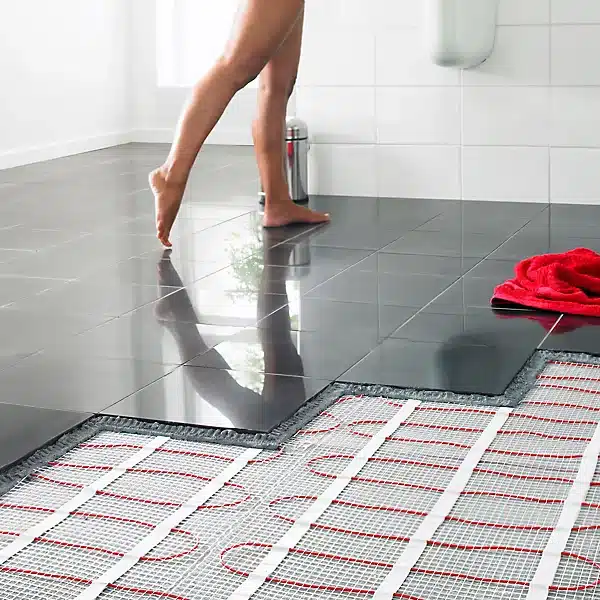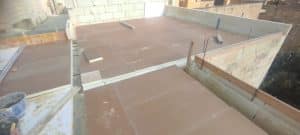When it comes to getting the most out of your underfloor heating system, especially with tiled floors, temperature control is everything. The right underfloor heating temperature for tiled floors not only ensures your home feels wonderfully warm but also protects your flooring, optimises energy use, and prolongs the lifespan of your heating system.
If you’re in Malta, where mild winters and cool tiled floors meet, understanding the ideal underfloor heating temperature for tiled floors can make the difference between cozy comfort and costly mistakes. Let’s dive into everything you need to know.
1. Why Temperature Matters for Tiled Floors
Tiles are a fantastic choice for homes in Malta—they’re stylish, durable, and perfect for keeping homes cool in summer. But come the cooler months, that chill underfoot can be a little less inviting. That’s where underfloor heating steps in, offering radiant warmth that evenly spreads across your floor.
However, not all heat settings are created equal. Set the temperature too low, and you’ll hardly feel the benefit; too high, and you risk damaging both your tiles and the heating elements beneath them. Maintaining the correct underfloor heating temperature for tiled floors ensures:
Comfort – Warmth that feels natural and not overly hot.
Energy Efficiency – Lower bills and less environmental impact.
Floor Longevity – Preventing cracks, warping, or adhesive damage.
In general, experts recommend keeping the surface temperature of tiled floors between 25°C and 29°C, depending on the space and comfort preference.
2. The Ideal Underfloor Heating Temperature for Tiled Floors
If you’re looking for the sweet spot, most homes in Malta find comfort in the range of 27°C to 29°C for tiled floors. This temperature range provides sufficient warmth without overloading the system or causing floor damage.
Here’s a quick breakdown:
| Room Type | Ideal Floor Temperature | Notes |
|---|---|---|
| Living Room | 27°C – 29°C | Best for lounging comfort. |
| Bathroom | 28°C – 30°C | Slightly warmer for barefoot use. |
| Kitchen | 26°C – 28°C | Warmer areas can still be energy efficient. |
| Bedroom | 25°C – 27°C | Slightly cooler for better sleep. |
For tiled floors, the heat-up time is quick because ceramic and porcelain conduct heat efficiently, but they also lose it quickly when turned off—making temperature consistency important.
3. Balancing Comfort and Energy Efficiency
It’s tempting to crank up the heat on a chilly morning, but this can quickly lead to unnecessary energy costs. The key to smart heating is balance.
Consider these tips for optimising your underfloor heating temperature for tiled floors:
Use a programmable thermostat – This allows you to schedule heating only when you need it.
Avoid frequent extreme adjustments – Letting the system maintain a steady temperature is more efficient.
Set a night-time setback temperature – Lowering by 2–3°C at night saves energy without letting floors go cold.
For Malta, where electricity costs can be on the higher side, a little planning can save you hundreds of euros over the winter.
4. Factors That Affect the Perfect Temperature
While we’ve given you the general numbers, your perfect underfloor heating temperature for tiled floors can depend on several factors:
Tile Material – Porcelain retains heat slightly better than ceramic.
Tile Thickness – Thicker tiles may take longer to heat but can hold warmth longer.
Room Insulation – Well-insulated homes need less heating power.
Heating System Type – Electric systems respond faster; water-based (hydronic) systems have a slower heat-up but retain warmth.
💡 Pro Tip for Malta Homes: Older stone or traditional tiled floors in townhouses may require slightly higher settings due to heat loss through uninsulated subfloors.
5. Common Mistakes to Avoid
To keep your tiled floors safe and your bills low, avoid these temperature mistakes:
Overheating – Going beyond 30°C on tiles risks damaging grout and adhesives.
Switching the System On and Off Frequently – This uses more energy than maintaining a steady setting.
Ignoring Manufacturer Guidelines – Always check the tile supplier’s recommended max temperature.
Not Considering Furniture Layout – Avoid heating areas under large fixed furniture to prevent trapped heat.
Remember, the underfloor heating temperature for tiled floors is not just about comfort—it’s about protecting your investment.
6. Costs of Running Underfloor Heating in Malta
Underfloor heating can be more affordable than you think—especially with modern efficiency controls. On average:
Electric Underfloor Heating – Costs around €0.12–€0.20 per hour per m² at standard temperature ranges.
Water-Based Systems – Slightly cheaper to run, but higher upfront installation costs.
A well-set thermostat and optimal underfloor heating temperature for tiled floors can keep your monthly heating costs in the range of €40–€80 for a medium-sized home in Malta.
7. Real-Life Example: Comfort in a Maltese Winter
Imagine stepping into your Valletta apartment on a January evening. Outside, the temperature is around 12°C, but inside, your sleek ceramic tiles feel pleasantly warm underfoot at 28°C. The heat is gentle, consistent, and—thanks to your programmable thermostat—costing you less than €2 a day to run.
This is the comfort and efficiency that the right underfloor heating temperature for tiled floors can bring.
Fine-Tuning the Perfect Underfloor Heating Temperature for Tiled Floors
While we’ve covered the basics of ideal heat ranges, achieving the perfect underfloor heating temperature for tiled floors in Malta is about finding a balance between comfort, efficiency, and longevity. This is where smart controls, zoning, and seasonal adjustments come into play.
For instance, you might set your system at 24°C in autumn when the evenings start to feel cool, and slightly lower it in early spring to save energy. By fine-tuning settings based on outside conditions, you ensure your tiled floors stay warm without wasting euros. Smart thermostats make this effortless, learning your habits and adjusting temperatures automatically.
Seasonal Temperature Adjustments for Maximum Comfort
Malta’s mild winters don’t require extreme heating, but consistency is key. A steady underfloor heating temperature for tiled floors between 22°C and 26°C during winter ensures comfort without overspending on electricity. In summer, when underfloor heating isn’t needed daily, you can still use it occasionally in bathrooms or tiled kitchens to remove the chill from early mornings.
These small seasonal tweaks not only save on your electricity bill but also prevent sudden temperature shocks to your tile flooring, preserving its appearance for years to come.
The Role of Tile Material in Temperature Control
Not all tiles hold or transfer heat equally, which can impact your chosen underfloor heating temperature for tiled floors. Porcelain tiles, for example, heat quickly and retain warmth longer, meaning you can often set your thermostat slightly lower. Natural stone tiles, on the other hand, might require slightly higher settings to reach the same comfort level but will hold heat for longer once warmed.
Understanding your tile material can help you choose the most efficient temperature settings and avoid overworking your heating system.
Avoiding Overheating and Damage
One of the biggest mistakes homeowners make is pushing their underfloor heating temperature for tiled floors too high. While tiles can withstand heat, excessive temperatures (above 29°C) can damage adhesives or cause hairline cracks over time. Overheating can also dry out grout, leading to maintenance issues.
The goal is to keep the system warm enough for comfort but well below the maximum safety limits, especially in Malta’s relatively mild climate.
How Smart Thermostats Transform Comfort Levels
Modern smart thermostats give you unmatched control over the underfloor heating temperature for tiled floors. They let you schedule heat cycles, create zones for different rooms, and even adjust settings remotely via an app. For example, you could have your bathroom floor pre-warmed to 25°C just before your morning shower, then drop it to 20°C while you’re at work.
These adjustments help maintain comfort while significantly reducing annual running costs. Many homeowners in Malta find that upgrading to a smart thermostat pays for itself within the first year in energy savings.
Investing in the Right Installation for Optimal Results
Even the most precise underfloor heating temperature for tiled floors won’t work effectively without proper installation. Insulation boards, correct spacing of heating cables, and professional setup ensure even heat distribution and energy efficiency. Skipping on quality installation could mean cold spots or higher bills.
That’s why it’s crucial to choose an experienced provider. At Kibitec, we ensure your system is tailored to your home, your tiles, and your comfort needs.
Energy Efficiency and Cost Savings
Maintaining the right underfloor heating temperature for tiled floors isn’t just about comfort—it’s also a matter of reducing energy bills. In Malta, where electricity costs can add up quickly, setting your system at an optimal temperature helps avoid unnecessary expenses. For example, keeping your floors at 23°C instead of 27°C could save you up to 15% annually on heating costs.
Impact of Room Size and Layout
The right underfloor heating temperature for tiled floors can also depend on the room’s size and shape. Larger, open-plan living areas may require slightly higher temperatures to achieve even warmth, while smaller rooms can heat up efficiently at lower settings. Proper zoning allows each area to maintain its ideal temperature without overworking the system.
Thermal Comfort Beyond Numbers
While a thermostat shows a specific reading, perceived warmth can vary. The right underfloor heating temperature for tiled floors is one that feels cozy underfoot without overheating the air in the room. Factors like humidity, floor insulation, and air movement all influence how warm the floor feels, even if the temperature is technically the same.
Pairing with Other Heating Sources
In some Malta homes, the underfloor heating temperature for tiled floors is supplemented with other systems, like radiators or air conditioning units with heating functions. By using these in tandem, you can keep the floor temperature slightly lower while maintaining overall room comfort, which can extend the lifespan of your heating system.
Quick Warm-Up Tips
If you want your tiles to feel warm quickly, pre-heating with a higher underfloor heating temperature for tiled floors (by 2–3°C above your usual setting) for 30 minutes before use can make a noticeable difference. After that, reducing it to your regular comfort level helps save energy while keeping the floor pleasant to walk on.
Long-Term Maintenance and Performance
To ensure your chosen underfloor heating temperature for tiled floors remains consistent over the years, it’s important to carry out regular maintenance. This includes checking thermostat calibration, inspecting heating cables, and cleaning tile grout to prevent insulation issues. A well-maintained system will heat faster, cost less to run, and last significantly longer.
Adapting to Malta’s Mild Winters
In Malta, winters are relatively mild, but tiled floors can still feel chilly. Adjusting the underfloor heating temperature for tiled floors to suit the season prevents overheating while ensuring comfort. For example, during a Maltese winter, 21–23°C is often more than enough to keep living areas cozy without wasting energy.
Smart Thermostat Integration
Modern smart thermostats make managing the underfloor heating temperature for tiled floors effortless. They can learn your daily routine, adjusting temperatures automatically to match when you’re home or away. This not only increases comfort but also cuts down on unnecessary electricity usage, which is especially important in Malta’s energy-conscious market.
Avoiding Damage to Tiles and Grout
Setting the underfloor heating temperature for tiled floors too high can cause expansion stress in tiles and grout lines. Over time, this may lead to cracking or discoloration. Keeping temperatures within the manufacturer’s recommended range ensures both the performance of your heating system and the longevity of your flooring.
The Role of Proper Insulation
Even the perfect underfloor heating temperature for tiled floors can be wasted without proper insulation beneath the tiles. High-quality insulation boards help direct heat upward, reducing warm-up times and improving efficiency. In Malta’s homes, where energy efficiency is becoming a priority, investing in insulation is a smart move.
Balancing Comfort and Energy Costs
Finding the right underfloor heating temperature for tiled floors is a balance between comfort and efficiency. In Malta, energy prices can be a concern, so keeping temperatures in the optimal range helps maintain warmth without skyrocketing electricity bills. This way, you enjoy a cozy home while keeping monthly costs predictable.
Consulting with Local Experts
Choosing and maintaining the ideal underfloor heating temperature for tiled floors is easier when you have professional guidance. Local experts understand Malta’s climate, tile materials, and energy tariffs, allowing them to recommend the perfect setup for your needs. A quick consultation can save you both time and money in the long run.




